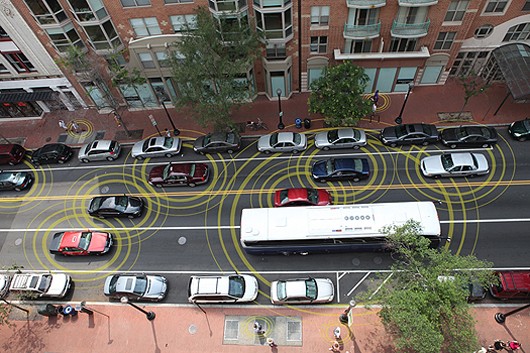DOT and Connected Vehicle Technology Study in Michigan
The biggest connected vehicle crash avoidance technology study was launched August 21st by the US Department of Transportation (DOT), the University of Michigan and automotive electronics maker Denso in Ann Arbor, Michigan. Almost 3,000 buses, trucks and cars fitted with connected Wi-Fi technology means that infrastructure and vehicles can communicate in real time. This technology, designed to improve the traffic flow and help avoid crashes, is set to commence traversing the streets on Ann Arbor during the two year pilot project to test their Talking Car Technology.
The Safety Pilot Model Deployment conducted by University of Michigan’s Transportation Research Institute (UMTRI), will be a real world test of connected vehicle technology. It is actually the second phase of the two year long pilot project, and data from a series of “driver acceptance clinics” from the first phase has already released, showing a remarkably favourable response from drivers regarding their experience of Vehicle to Vehicle, or V2V safety features. In fact, 9 out of 10 drivers said they would like their own vehicle to be equipped with V2V safety features.
During the second phase, voluntary participants have supplied the vehicles for the most part and these test trucks, buses and cars are equipped with communication devices that collect detailed data about the system’s effectiveness and operability in terms of crash reduction.
Denso, as well as other worldwide brands, have been developing connected vehicle technologies for nearly a decade in a bid to ensure that roadways of the future are a safer place.
Big companies are already on board.
Car-to-X communications, also known as ‘Talking Car’ are currently being tested in other countries. Denso is also an associate member of a test program in Frankfurt, Germany. The German state Hessen, Daimler, Volkswagen Group and BMW Group are also participating in the study, as well as other manufacturers from Europe and Japanese automakers.
Two Digital Short-Range Communication (DSRC) devices are being tested. It is hoped that in the future, one of the DSRC devices can be integrated into new cars at the point of manufacture. The second device is designed to be retrofitted into existing vehicles. Wi-Fi hotspots have been set up around Ann Arbor at points known as ‘connected intersections’ and Denso is aiming to roll this technology out across U.S roadways in the next few years.
This effectively means that in the future, trucks and cars will be able to ‘talk’ to each other and the infrastructure on which they are driving. Not only will this help to prevent crashes, but it should also make the experience of driving far more relaxed and pleasant than it is today.
Connected Vehicle technologies won’t just be useful in terms of accident prevention at intersections, but it will also be able to alert drivers to emergency vehicles on the road, obstacles and bad weather. In fact, it could also provide drivers with the best route based on traffic-lights cycles.
DOT’s National Highway Traffic Safety Administration (NHTSA), are confident that four out of five vehicle crashes could be avoided altogether, or the severity could be reduced thanks to V2V safety technology. Electronic data messages will be sent from model deployment vehicles, as well as received from other vehicles equipped with the same technology. Data is translated into a warning to flag up hazardous scenarios such as a rear collision with a vehicle stopped ahead, or even an impending collision at a blind intersection.
Although this vehicle to vehicle communication could potentially transform roadway safety as we know it today, it’s crucial that it’s tested and that we know how to apply it in the most effective way. This pilot study aims to gather data on just how this all translates in the real world.

